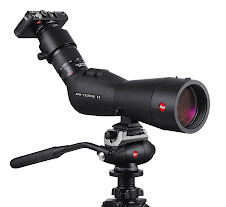

Wilson's Plover digiscoped w/ Leica APO Televid 77 & C-Lux 2 camera
The image above was taken 2 years ago on the "beach photo safari" at the Florida Bird & FotoFest in St. Augustine, FL. The walk is designed for long lens photogs to get images of gulls, terns, and shorebirds in late evening light. They are driven out to a distant point of a barrier island where these birds concentrate. When they arrive, they target a specific bird or group of birds, then drop to their bellies and slowly crawl across the sand toward their subjects.
I went along to bird and see what was out there as this point would normally require a VERY long trudge through sand taking a couple hours. As the happy photogs were slowly inching toward their subjects I happily snapped a few shots from the truck over their heads not even bothering to crouch let alone belly crawl.
Then I continued birding recording over 30 species of birds including other gems like Snowy Plover, Lesser Black-backed Gull, Northern Gannet, Red Knot, and 6 species of terns. I was the only one in the group carrying binoculars let alone a scope. About an hour later one happy photog returned to the truck wet and cold, and proudly showed me his best image. He didn't know what it was but was thrilled with the result he'd gotten and asked me what it was. I explained it was a Wilson's Plover and pulled my point & shoot out of my pocket and showed him near the exact image as seen above. So in this instance at least it seemed that digiscoping produced near the same exact result with much less effort with a lot of time left over to appreciate the many bird species out there.
Granted, if a Peregrine had winged up the beach, I would not have gotten an image likely by digiscoping, but I'd still have enjoyed the view of the mighty bird streaking past. If one of the beach bound photographers had even noticed the bird going by and knelt or stood up they might have gotten the image, but would still not have the appreciation for the powerful flight with wingtips arcing smoothly up and then rolling downward like a wave while peering through their small viewfinders.
As I said at the outset, it's just a matter of preference and perspective and under varying conditions each style of photography will outperform the other. If you are more likely to tuck the binoculars away and do without a scope, and are willing to creep or sneak in on birds to get within 20-30', then the DSLR with telephoto is likely the way for you. For me though, I prefer to simply setup the scope, mount the camera and take the shot to not miss too much of the wildlife activities around me.



great post jeff. i think a lot of digiscopers feel this way. i dont think it is better or worse than traditional super-telephoto photography, just different.
ReplyDeleteI love the extra reach the scope gives me and it is just another reason to get myself out there to look for birds.
happy birding
Dale
http://alpinebirds.blogspot.com
I hear that Dale!
ReplyDeleteIs there a cable release adapadapter that can be used with the leica apo televid 82 scope, D-Lux 4 camera with d-lux 4 camera adapter?
ReplyDeleteyes there is a great after market product available here. it's inexpensive and effective i purchased one to use myself.
ReplyDeletesee it here:
http://www.westcoastcameras.com/index.php?l=product_detail&p=4798
Jeff,
ReplyDeleteJust discovered your wonderful blog. Thanks for sharing the stunning pictures. I am an amatuer photographer. I mostly take landscape/nature photo's. Have recently discovered the world of digiscoping and purchased a Kowa scope. I am using it with a Nikon D90. I'm thinking maybe a P&S would be better as my setup is quite bulky and heavy. Any suggestions on a P&S?
Sally - morganlaneww@yahoo.com
Sally,
ReplyDeleteI honestly haven't experimented with Kowa stuff but my buddy Paul Hackett in the UK is an absolute whiz with his. Try googling him or google "Kowa digiscoping" and see if you can find him.